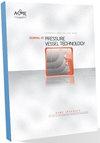管模膨胀过程中驱动力和应力的计算方法
IF 1.4
4区 工程技术
Q4 ENGINEERING, MECHANICAL
Journal of Pressure Vessel Technology-Transactions of the Asme
Pub Date : 2023-01-05
DOI:10.1115/1.4056604
引用次数: 0
摘要
在本研究中,采用基于能量法的分析方法来估计不同模具形状膨胀管所需的力。该方法采用体积能量变化和工作效果比来计算驱动力,而不是以往研究中依赖于接触压力和接触面形状。新方法大大降低了分析的难度,简化了计算。由于准确的过渡区应力分布是确定工作影响因子的关键,本文还引入了一种新的自适应分析方法来估计膨胀管过渡区的应变和应力分布,并通过该方法可以得到模具与管的接触位置。在本研究中,采用三个有限元模型作为数值方法,建立了包含多个线性运动硬化行为的轴对称模型来验证该方法。此外,铜和钢3/8英寸管扩展与椭圆模具设计的测试工作台上不同的边界条件。对膨胀过程中的切向、纵向应变和驱动力进行了监测和记录。最后,三种方法的结果显示出很好的一致性。本文章由计算机程序翻译,如有差异,请以英文原文为准。
A Method of Evaluating the Driving Force and Stresses During Tube Die Expansion
In this study, an analytical approach based on the energy method is used to estimate the force required to expand tubes for different die shapes. The proposed method calculates the driving force by the volume energy change and working effect ratio instead of depending on the contact pressure and the shape of the contact surface in the previous studies. The new approach greatly reduces the difficulty of the analysis and simplifies the calculation.
Since the accurate stress distribution in the transition zone is essential for determining the working effect factor, a new analytical approach with self-adaption is also introduced to estimate the strain and stress distribution in the transition zone of an expanding tube, and the contact position between die and tube can also be obtained by this approach.
In this study, three finite element models as a numerical approach are used to develop an axisymmetric model including multiple linear kinematic hardening behavior to confirm the approach. Additionally, copper and steel 3/8 inch tubes are expanded with oval dies on a designed test workbench with different boundary conditions. The tangential, longitudinal strains and driving force are monitored and recorded during the expansion process.
Finally, the results from the three approaches show a very good agreement.
求助全文
通过发布文献求助,成功后即可免费获取论文全文。
去求助
来源期刊
CiteScore
2.10
自引率
10.00%
发文量
77
审稿时长
4.2 months
期刊介绍:
The Journal of Pressure Vessel Technology is the premier publication for the highest-quality research and interpretive reports on the design, analysis, materials, fabrication, construction, inspection, operation, and failure prevention of pressure vessels, piping, pipelines, power and heating boilers, heat exchangers, reaction vessels, pumps, valves, and other pressure and temperature-bearing components, as well as the nondestructive evaluation of critical components in mechanical engineering applications. Not only does the Journal cover all topics dealing with the design and analysis of pressure vessels, piping, and components, but it also contains discussions of their related codes and standards.
Applicable pressure technology areas of interest include: Dynamic and seismic analysis; Equipment qualification; Fabrication; Welding processes and integrity; Operation of vessels and piping; Fatigue and fracture prediction; Finite and boundary element methods; Fluid-structure interaction; High pressure engineering; Elevated temperature analysis and design; Inelastic analysis; Life extension; Lifeline earthquake engineering; PVP materials and their property databases; NDE; safety and reliability; Verification and qualification of software.

 求助内容:
求助内容: 应助结果提醒方式:
应助结果提醒方式:


